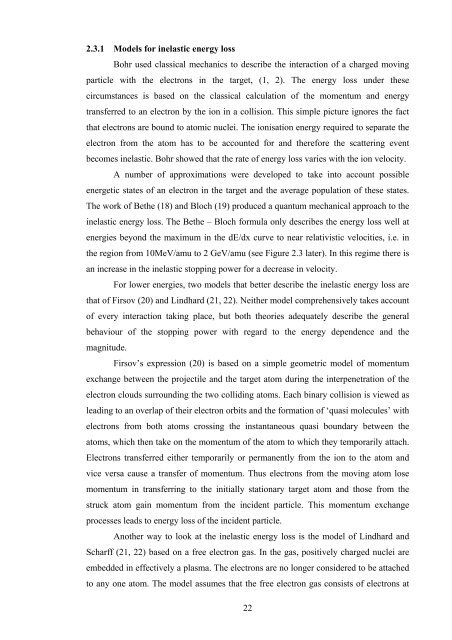Damage formation and annealing studies of low energy ion implants ...
Damage formation and annealing studies of low energy ion implants ...
Damage formation and annealing studies of low energy ion implants ...
Create successful ePaper yourself
Turn your PDF publications into a flip-book with our unique Google optimized e-Paper software.
2.3.1 Models for inelastic <strong>energy</strong> loss<br />
Bohr used classical mechanics to describe the interact<strong>ion</strong> <strong>of</strong> a charged moving<br />
particle with the electrons in the target, (1, 2). The <strong>energy</strong> loss under these<br />
circumstances is based on the classical calculat<strong>ion</strong> <strong>of</strong> the momentum <strong>and</strong> <strong>energy</strong><br />
transferred to an electron by the <strong>ion</strong> in a collis<strong>ion</strong>. This simple picture ignores the fact<br />
that electrons are bound to atomic nuclei. The <strong>ion</strong>isat<strong>ion</strong> <strong>energy</strong> required to separate the<br />
electron from the atom has to be accounted for <strong>and</strong> therefore the scattering event<br />
becomes inelastic. Bohr showed that the rate <strong>of</strong> <strong>energy</strong> loss varies with the <strong>ion</strong> velocity.<br />
A number <strong>of</strong> approximat<strong>ion</strong>s were developed to take into account possible<br />
energetic states <strong>of</strong> an electron in the target <strong>and</strong> the average populat<strong>ion</strong> <strong>of</strong> these states.<br />
The work <strong>of</strong> Bethe (18) <strong>and</strong> Bloch (19) produced a quantum mechanical approach to the<br />
inelastic <strong>energy</strong> loss. The Bethe – Bloch formula only describes the <strong>energy</strong> loss well at<br />
energies beyond the maximum in the dE/dx curve to near relativistic velocities, i.e. in<br />
the reg<strong>ion</strong> from 10MeV/amu to 2 GeV/amu (see Figure 2.3 later). In this regime there is<br />
an increase in the inelastic stopping power for a decrease in velocity.<br />
For <strong>low</strong>er energies, two models that better describe the inelastic <strong>energy</strong> loss are<br />
that <strong>of</strong> Firsov (20) <strong>and</strong> Lindhard (21, 22). Neither model comprehensively takes account<br />
<strong>of</strong> every interact<strong>ion</strong> taking place, but both theories adequately describe the general<br />
behaviour <strong>of</strong> the stopping power with regard to the <strong>energy</strong> dependence <strong>and</strong> the<br />
magnitude.<br />
Firsov’s express<strong>ion</strong> (20) is based on a simple geometric model <strong>of</strong> momentum<br />
exchange between the projectile <strong>and</strong> the target atom during the interpenetrat<strong>ion</strong> <strong>of</strong> the<br />
electron clouds surrounding the two colliding atoms. Each binary collis<strong>ion</strong> is viewed as<br />
leading to an overlap <strong>of</strong> their electron orbits <strong>and</strong> the <strong>format<strong>ion</strong></strong> <strong>of</strong> ‘quasi molecules’ with<br />
electrons from both atoms crossing the instantaneous quasi boundary between the<br />
atoms, which then take on the momentum <strong>of</strong> the atom to which they temporarily attach.<br />
Electrons transferred either temporarily or permanently from the <strong>ion</strong> to the atom <strong>and</strong><br />
vice versa cause a transfer <strong>of</strong> momentum. Thus electrons from the moving atom lose<br />
momentum in transferring to the initially stat<strong>ion</strong>ary target atom <strong>and</strong> those from the<br />
struck atom gain momentum from the incident particle. This momentum exchange<br />
processes leads to <strong>energy</strong> loss <strong>of</strong> the incident particle.<br />
Another way to look at the inelastic <strong>energy</strong> loss is the model <strong>of</strong> Lindhard <strong>and</strong><br />
Scharff (21, 22) based on a free electron gas. In the gas, positively charged nuclei are<br />
embedded in effectively a plasma. The electrons are no longer considered to be attached<br />
to any one atom. The model assumes that the free electron gas consists <strong>of</strong> electrons at<br />
22
















